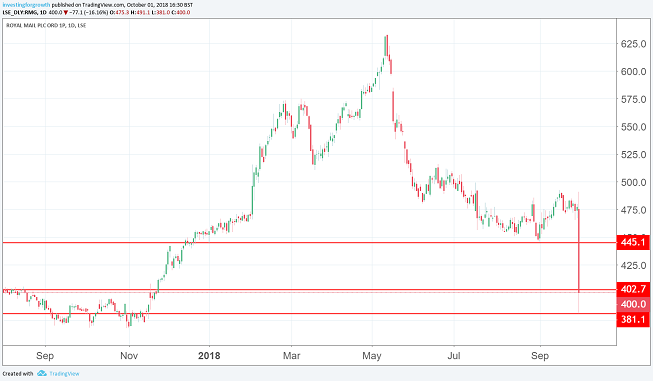Royal Mail crashes after shock profits warning
1st October 2018 15:48
by Lee Wild from interactive investor
With just an hour to go until the stockmarket shut for the day, a 'kitchen sink' job from Royal Mail's new CEO plunged the shares to an 11-month low, reports Lee Wild.

Why release a profits warning at 7am when you can catch traders napping with a stinker just an hour before the market closes.
That's what Royal Mail did Monday. With dealers ruing a quiet start to the week on domestic equity markets, the letters and parcels giant delivered a shocking warning that sent the share price down as much as 20%.
With the share price now down around 40% from May's peak, the rally from last October's low at around 368p has now almost completely unwound.
That's because new chief executive Rico Back and his team have been reviewing the business and "strategic direction". Clearly, they didn't like what they saw.
A reassessment of expectations for 2018-19 sees forecasts for adjusted operating profit before transformation costs drop to between £500 million and £550 million. In the year to March 2018, the company made £694 million, down from £712 million in 2017.
While 6% growth in first-half revenue and volume at the UK parcels business should mean a better year there, problems at GLS are a concern. Interim revenue is seen up 9%, but this is Royal Mail's jewel in the crown, and news that labour market and "other cost pressures" are impacting margins more than expected is bad news.
We know that letter volumes are in structural decline, so further confirmation here is not necessarily a needle-mover, but addressed letter volume is down 7% in the first half and will likely be down a similar amount for the 12 months. That's worse than the existing medium-term outlook for annual declines of 4-6%.

Source: TradingView (*) Past performance is not a guide to future performance
"Trading conditions in the UK are challenging. Our letter volumes, especially marketing mail, are impacted by ongoing structural decline, business uncertainty and GDPR," warns Back.
"Our UK productivity and cost performance has been disappointing. Against this backdrop, we are lowering our targets for cost avoidance and productivity improvements for 2018-19."
Problems here revolve around the pay, pensions and pipeline agreement following a long industrial dispute concluded in March. Delivering the required productivity increases is taking longer than anticipated, and means UK productivity is "significantly below plan" at 0.1%. It will also likely be "significantly below" the full-year target of 2-3%.
As well as more than halving its cost cuts target for this year from £230 million to £100 million, Royal Mail is also reassessing efficiency and productivity opportunities under the agreement.
Although we're still a few months away from the next FTSE reshuffle, Royal Mail will be relegated from the FTSE 100 again if it fails to recover from this significant sell-off.
For now, Royal Mail remains committed to its progressive dividend policy which, at the current share price and based on last year's annual payout of 24p, gives an historic yield of 6.1%.
*Horizontal lines on charts represent previous technical support and resistance.
These articles are provided for information purposes only. Occasionally, an opinion about whether to buy or sell a specific investment may be provided by third parties. The content is not intended to be a personal recommendation to buy or sell any financial instrument or product, or to adopt any investment strategy as it is not provided based on an assessment of your investing knowledge and experience, your financial situation or your investment objectives. The value of your investments, and the income derived from them, may go down as well as up. You may not get back all the money that you invest. The investments referred to in this article may not be suitable for all investors, and if in doubt, an investor should seek advice from a qualified investment adviser.
Full performance can be found on the company or index summary page on the interactive investor website. Simply click on the company's or index name highlighted in the article.